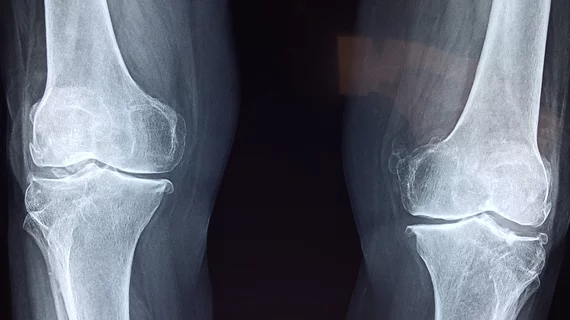Which interventional radiology procedure is most cost-effective for treating knee osteoarthritis?
One particular interventional radiology procedure is most cost-effective for treating knee osteoarthritis, according to a new analysis published Wednesday
The degenerative joint disease is a leading cause of chronic pain and long-term disability in adults, with over 80% of cases affecting the knee. Osteoarthritis impacts more than 595 million people worldwide and produces $80 billion in healthcare costs in the U.S. alone, experts detailed in the American Journal of Roentgenology [1].
Given the high costs and morbidity attached to surgery, more treatment options are needed. Researchers aimed to assess the cost effectiveness of three nonsurgical options. These included injecting steroids into the joint, using radio waves to burn off the nerves causing the pain, or reducing blood flow to the lining of the knee via embolization.
They found that the latter—commonly referred to as genicular artery embolization or GAE—makes the most economic sense when compared to the other two.
“Across scenarios, GAE was consistently the most likely cost-effective treatment option compared to [radiofrequency ablation] and [corticosteroid injection], although clinical success rates, attrition rates and utility values impact its cost-effectiveness,” Daniel H. Kwak, MD, PhD, with the Department of Radiology at the University of Chicago Medical Center, and co-authors concluded.
To reach their results, Kwak et al. performed a modeling study from a U.S. Medicare payer’s perspective spanning over a four-year treatment period. They incorporated each of the three treatments’ success and attrition rates, along with costs and utility benefits. Values for the latter were derived at both the short term (0.5 to 3 months) and longer term (6-12 months) after treatment. Researchers conducted the study using a willingness-to-pay threshold of $100,000 per quality-adjusted life year.
Ablation demonstrated greater treatment effectiveness than embolization (injecting tiny beads into the arteries that supply blood to the knee lining). This was more pronounced at the short-term stages than the long-term ones. Cost-effectiveness ratios relative to steroid injection were $561-$1,563 per quality-adjusted life years for embolization and $76-$429 for ablation. Artery embolization also demonstrated higher cost-effectiveness probability (42%-55%) than radiofrequency ablation (18%-29%).
“Interpretation of the results is limited by the model’s cost inputs, namely the Medicare reimbursements provided,” the authors cautioned. “Costs can differ substantially even among Medicare payment rates due to geographic differences. Private insurance payers may also reimburse at substantially different rates. The study at least partially addressed this issue by utilizing broad cost ranges for each treatment in sensitivity analyses.”
You can read much more about the study, including potential limitations, at the link below.

